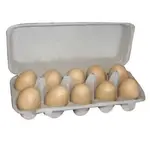It is a shell game, but the reason we see it is simple . . . but most of us miss it. It stems back to the price controls of the Richard Nixon era. (Don't blame the Dems for this, because it was a REPUBLICAN idea that has screwed us for decades!)
There was a price freeze. All prices had to stay the same on every item you sold. Well, some genius figured out a way around the problem (give business a chance and they can always find a new way to screw you).
If you could not raise the price on the existing 16 oz can of coffee, what if you put it in a new package of 15 oz? Well there was no 15 oz price that you had to adhere to because you had never sold a 15 oz can of coffee. Now, if you can sell 15 oz for the same price as you were getting for 16 oz, then let's start selling it in 14 oz or 13 oz.
This accomplishes 1 thing for the merchant & manufacturer: They could get around the price freeze and make more on each ounce of coffee even during a government enforced price freeze.
This accomplishes 1 thing for the government: Since there was never a 15 oz package of coffee, the fact that your cost per ounce increases will not show up in the consumer price index because these are based on the packages being the same size. A new package --- even if the price per ounce doubles --- cannot be compared to a different package. Then it went from full ounces to partial (1/2 oz or 1/10 oz difference from the previous package).
They found this also worked by making a new cut of meat, or even "renaming" an old one.
Best of all, no one has to tell you that they have started giving you less product. You should read the label on every single package every single time you go shopping. This justified not telling us that the "per ounce" price actually increased without "inflation" happening in our economy.
The practice continues as a way to increase profits without the ignorant masses noticing, and having to face something like the beef price protests of the 1970's. Ground beef had reached historic price levels, the housewives of the US protested and the price came back down to near or below $1 per pound.







